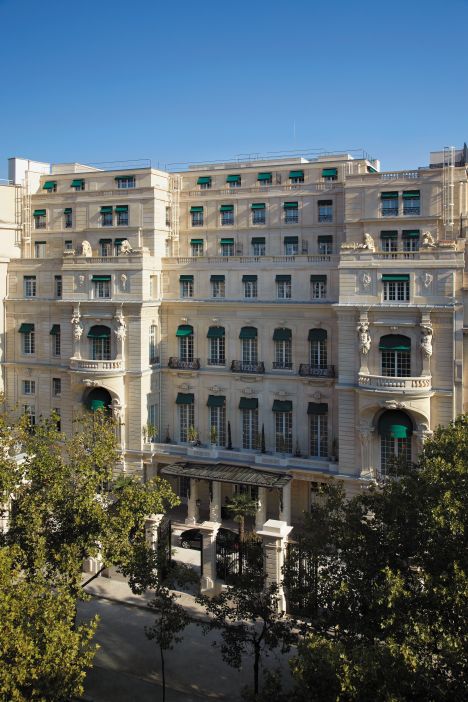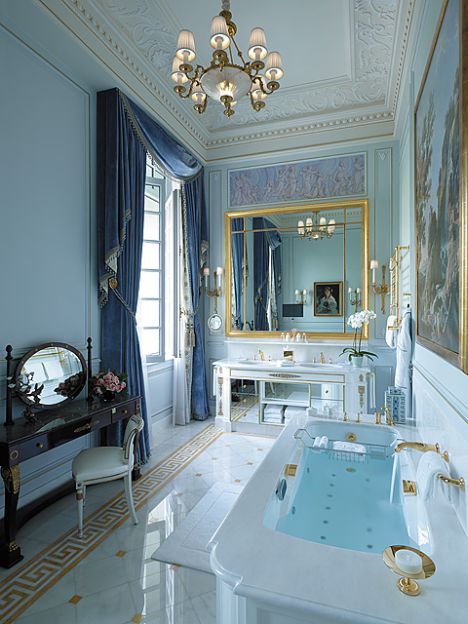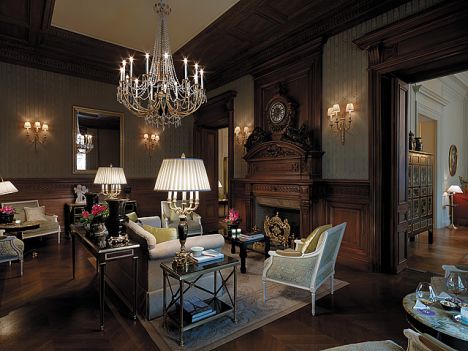
Review, photos, history and design of the luxury hotel facing the Eiffel Tower
Together with London, the French capital offers the greatest range of luxury hotels in Europe. The elegant Shangri-La hotel Paris is among the newest and the best.
Palais Iéna : a building full of history
The five-star hotel is situated at avenue d’Iéna 10, just a few steps from the square bearing the same name. Place d’Iéna is named after the twin battles of Jena and Auerstedt fought in 1806 between the armies of Napoleon I and Frederick William III of Prussia, which ended in a decisive defeat by the Prussians and their subjugation to the French Emperor. The square features a bronze sculpture of George Washington riding a horse by the American artist Daniel Chester French. In 1900, it was donated by a committee of wealthy American ladies to the French in memory of the fraternal aid given by the French to America during the War of Independence.

View of the Eiffel Suite. Photo copyright © Shangri-La hotel, Paris.
Roland Bonaparte
The building of the Shangri-La hotel in Paris itself offers plenty of history. Palais Iéna opened in 1896 as the residence of Prince Roland Bonaparte (1858-1924). The explorer, geographer and botanist was the grandson of Lucien Bonaparte, a younger brother of Napoleon Bonaparte, the emperor mentioned above who defeated the Prussians. Roland’s father was Pierre Napoleon Bonaparte, a colorful but penniless man, his mother was Justine-Eléonore Ruffin, the daughter of a Paris plumber working as a doorman.
By the time the grand-nephew of the famous French emperor was born, the family fortune had already been lost. Roland Bonaparte was lucky to marry Marie-Félix Blanc in 1880. According to the Shangri-La’s chef concierge Tony Le Goff, this was the result of clever tactics by Bonaparte’s mother. She opened a boutique in London, which was unacceptable for the rich members of the Bonaparte family; a Princess Bonaparte could not run a bourgeois business. She was offered money to close the boutique.
Marie-Félix Blanc was the daughter of François Blanc. The French mathematician and financier had studied gambling and introduced the Zéro and Doublezéro, increasing the bank’s winning chances in Roulette. Together with his twin brother Louis in Bordeaux, he first made a fortune through insider trading, speculating at the Paris stock exchange. They later operated a casino in Luxemburg and then in Homburg, where they abandoned the Doublezéro, increasing the players’ chances and therefore attracting more gamblers. In 1863, François Blanc got a 50-year concession to run the casino in Monaco. After his death in 1877, his widow, Marie Blanc, took over the position of general manager of the Casinos of Monte Carlo and the Société des Bains de Mer.
In short, Roland Bonaparte married a filthy rich casino heiress. In 1886, new French legislation banned the relations of French rulers to serve in the armed forced. Roland Bonaparte was forced to abandon his military career and devoted himself henceforth to the study of geography, geology and ethnology. In the world’s largest, private herbarium, he cultivated some 2.5 million samples of some 100,000 herb and 200,000 fern species. His library comprised some 200,000 volumes, filling some six kilometers of shelf space!
In 1910, Roland Bonaparte was named president of the French Geographical Society and held this position until his death in 1924. In addition, he was a member of the Scientific Academy and was nominated its President in 1919. He made expeditions to the Americas, Lapland, the Far East, Indonesia, India, China, Tibet and Mongolia. His publications include, among others, works about Surinam, New Guinea and Mongolia.
The elegant Iéna Palace became a center for the Paris academic, scientific, artistic and social elite. Important parts of Prince Roland Napoleon’s collection of African and Asian (mostly religious) objects and artifacts can be admired at Quai Branly Museum on the other side of the Seine.
The Prince and Princess Roland Bonaparte had a daughter, Marie, born in 1882. The mother died a few months after giving birth. Roland Bonaparte was the last male descendant of the Lucien Bonaparte line.

View of the luxurious Shangri-La hotel Paris. Photo copyright © Shangri-La hotel, Paris.
Palais Iéna and its residents
From 1892 to 1896, Iéna Palace was built by architect Ernest Janty as a family residence for Roland Bonaparte, his mother and daughter; Ernest Janty is renowned for his reconstruction work at the Louvre and Tuileries palaces for Napoleon III. The eclectic design of Iéna Palace is a mix of 17th and 19th century architectural styles. The façade is inspired by Louis XIV style, with intricate stone masonry from a French region called L’Oise. Sculptors Steiner and Hougenade made sure the Bonaparte coat of arms, featuring lion heads and antlers, ornate the façade; Steiner and Hougenade had worked with Janty at the Louvre and Tuileries palaces.
In 1907, Princess Marie Bonaparte married Prince George of Greece and Denmark in a Greek Orthodox ceremony. Nevertheless, she later had an affair with the French prime minister Aristide Briand. She worked as a psychoanalyst, Sigmund Freud himself being her mentor, whom she helped escape from Nazi Germany.
One year after her father’s death in his private quarters at avenue d’Iéna in 1924, Princess Marie Bonaparte sold the palace to the Suéz Canal Bank Company, which transformed the estate into luxury apartments. Architect Michel Roux-Spitz added two floors and a cupola over part of the ground floor, inspired by Gustave Eiffel. Prince Roland Napoleon’s library was relocated to the Geographical Society and most of the Napoleonic memorabilia became part of the Malmaison Castle Museum, dedicated to Napoleonic history.
In the roaring 1920s and 1930s, among the famous tenants at Palais Iéna were Elsie de Wolfe aka Lady Mendl (1865-1950), the New York actress, interior designer and wife of British diplomat Sir Charles Mendl; the artist Jean-Gabriel Domergue (1889-1962), who famously painted La Parisienne; the Oliver Senn-Foulds family, who owned a famous collection of French paintings, including works by Courbet, Monet, Pissarro, Delacroix and Matisse, which the collector donated to the Musée du Havre.
In 1944, the French Center for Foreign Trade acquired the building. They added an additional floor in 1966. The new owners promoted France on the international level and welcomed foreign dignitaries and discussed international business agreements.
In 2006, Shangri-La Hotels and Resorts bought the palace and transformed it into the group’s first European hotel, which opened on December 17, 2010.
If you want more history, the area around the hotel is full of museums and historic buildings. Almost opposite the Shangri-La, on the other side of Iéna Square, you can find Guimet Museum of Asian Art, which features a recommendable Angkor exhibition (review in French) until January 13, 2014. Nearby museums and exhibition spaces include Palais de Tokyo, Museum of Man, Palais Galliera, Museum of Modern Art and the Marmottan Monet Museum, all within walking distance. The same can be said of the elegant avenue Montaigne and the Champs-Elysées, where you can shop until you drop dead.

La Suite Shangri-La living room. Photos copyright © Shangri-La hotel, Paris.
The Shangri-La hotel Paris
Shangri-La Hotels and Resorts are named after the legendary land in James Hilton’s novel Lost Horizon, published in 1933. You can find a copy in your bedside table. The hotels however are real, based on the core principles “sincerity, humility, helpfulness, respect, courtesy and selflessness”.
From 2006 to 2010, Iéna Palace was transformed into the Shangri-La hotel Paris by architect Richard Martinet and interior designer Pierre-Yves Rochon. The historic, listed building was preserved and married with contemporary luxury.
Original wood and marble floors were preserved were possible. Since 2009, the cast-iron gateway on avenue Iéna, the façade, rooftop, vestibule and gallery, the domed entryway, the stairway of honor, the ground-level family salons (smoking, billiard and waiting room) as well as the historic salons on the first floor and Roland Bonaparte’s private living quarters on the second floor are all listed with Monuments historiques as part of the French national heritage.
The first floor features three connecting, historic rooms: The Grand Salon, the Salle à manger and the Salon de famille. The Grand Salon is the palace’s principal reception space in Louis XIV style, with a white marble fireplace decorated with a trumeaux mirror. Two golden wood and marble tables, two crystal chandeliers as well as Bonaparte symbols such as imperial crowns, bees and lion heads ornate the room.
The Salle à manger is devoted to the glory of the emperor and features mahogany carvings of battle arms and military trophies within the upper arches above the salon doors and window opening on to the terrace. Among the salon’s highlight’s are two massive eagle statues, a Renaissance-inspired fireplace and a bronze relief replica of Jacques Louis David’s Napoleon Crossing the Alps; one of the five original versions can be admired at the Malmaison Castle Museum.
Delicate blue tones and artistic touches lend a graceful femininity to the Salon de famille, which is mainly decorated according the Empire style, with paneled walls depicting winged women around a medallion. The ceiling features an orb of sphinxes and plants.

The bathroom of the Suite Imperial. Photos copyright © Shangri-La hotel, Paris.
The hotel design : the rooms and suites at Shangri-La hotel Paris
Almost all Shangri-La rooms, such as my Eiffel Room 54, have entrances and bathroom floors made of St. Laurent black marble as well as bathroom walls made of beige moleanos marble, all by Demetra, whereas the carpets were purchased from Eulster. Ebene wood was used for the beds.
Out of 101 rooms and suites at the Paris Shangri-La, 37 feature terraces or balconies. The 16 Eiffel Rooms are the best deal in the hotel. They all offer huge terraces. My Eiffel Room 54 terrace featured two tables and four chairs, with enough space for at least another four chairs. You could organize a private party on my terrace, with a full view of the nearby Eiffel Tower! With the curtains up, I even enjoyed the Eiffel Tower view from my bathtub. No other Paris luxury hotel currently offers comparable terrace views!
Apart from the Signature Suites, interior designer Pierre-Yves Rochon opted for shades of blue, white and ecru for all rooms and suites. Silk-threaded wallpaper, textured wall panels and crystal hardware on custom-made furnishings ornate the spaces. Pierre-Yves Rochon got his inspiration from archive documents and photos of Palais Iéna and reworked and translated motifs, textures, wallpapers, lighting and bath fixtures of Prince Roland Bonaparte’s era into elegant 21st century designs.
Heated floors, separate bathtubs and rain showers as well as double sinks, flat-screen TVs with a huge selection of channels, complimentary Wifi and BVLGARI White Tea amenities in the bathroom are standard throughout the luxury hotel.
Although perfectly happy with my Eiffel Room 54, I had a quick look at two suites when they were in-between guests. Suite Chaillot 507 is situated on the fifth floor and offers 150 square meters of space, including a 70 square meter dining area with a table for up to six guests and a 40 square meter terrace overlooking Paris from Montmartre to the Eiffel Tower and beyond. You may even know Suite Chaillot from Condé Nast and Louis Vuitton photo shoots. I liked the Asian touch with Ming vases and an original Donghia tapestry depicting a forest scene. The color palate centers on shades of taupe and jade. Macassar ebony wood, hand-tooled metalwork, custom-made mirror-covered bedside tables with glass Bréhat handles and other details convey a feeling of calm elegance to the suite. The bathroom features a whirlpool and iridescent glass tile mosaics.
Suite Shangri-La 701 on the hotel’s top floor, which was added to the building in 1966, offers 225 square meter, including a 100 square meter teak and glass terrace. The dining table can hold up to eight guests. The Suite Shangri-La can be connected with four bedrooms, spanning the entire seventh floor with a total living space of 500 square meters. The unobstructed view from the suite’s terrace is unmatched. Interior designer Pierre-Yves Rochon opted for pearlescent Lelièvre panels, Canovas drapes and art deco details to decorate the suite.
Chief Concierge Tony Le Goff told me how he made the impossible possible for guests at Suite Shangri-La. For a Russian couple, he invited the wife’s favorite band from Moscow for a private, surprise concert in the suite. For another Russian couple who spent a week in 701, he organized trips on a private jet to Normandy as well as to the island of Corsica, where they enjoyed time on a yacht; the fresh lobster caught had been secretly put in a cage below the yacht. For legal reasons, fireworks could not be organized in Paris, but in a Corsica bay the concierge made it possible. For a group of American tourists, Tony Le Goff organized an exclusive trip to a private Loire Valley chateau, where the ladies landed with a helicopter and then helped the lady of the castle prepare a dinner in the kitchen. If you are looking for something unique to do or visit, ask Tony Le Goff!
The Suite Impériale was unfortunately occupied all the time when I stayed at the Shangri-La in Paris in November 2013. Therefore, I could not have a look around. It is the only hotel suite to be listed with Monuments historiques. Its beamed ceilings, castings, gilt works and decorative carvings are original and in the same style as the Grand Salon directly below. The bathroom is decorated in the late 18th century Directoire style, completely finished in marble and with crystal fixtures and accents. The suite’s balcony offers views of avenue Iéna and Guimet Museum.
The Shangri-La company is famous for its service. Details make a difference. I fondly remember my November 2013 welcome tea (thé d’accueil), an excellent Jasmine Chung Hao from the Chinese Fujian province by Betjeman-Barton. It was presented in a kind of picnic basket, which I took out on my fabulous Eiffel Tower Room terrace to enjoy while admiring the great construction by Gustave Eiffel.
In addition, all rooms offer coffee and teak making facilities; I remember a Krups coffee machine with Nespresso capsules as well as a Kenwood tea making facility in Eiffel Room 54. The Samsung flatscreen TV offered 78 channels, including several sports channels, which allowed me to watch Manchester United vs. FC Arsenal live on Sky Sports. A small TV screen is integrated in the bathroom mirror, which made it possible to watch the game even from the bathtub which, incidentally, offers Eiffel Tower view to the other side.
In addition to the BVLGARI White Tea amenities, the bathroom also offered scales, a vanity mirror with integrated light bulb, Gillette razor blades, Colgate Plax mouthwash, a comb and more.
The drawer of your writing table offers cables, adapters, adhesive tape, scissors and more useful office utensils. Again, details make the difference!
As for the culinary side, the elegant Shangri-La offers Western and Oriental classic dishes at restaurant La Bauhinia, where breakfast is served too. Shang Palace serves traditional Chinese, Cantonese inspired cuisine; it received a Michelin star in the 2013 guide. L’Abeille is the hotel’s third restaurant. Chef Philippe Labbé (French article) features creative variations on classic French dishes; it featured two Michelin stars in the 2013 guide. Last but not least, let’s mention the pastries by chef François Perret, who alone is worth a restaurant visit, especially for the afternoon tea. [Added on January 14, 2016: Since January 2015, Christophe Moret is the hotel’s executive chef and the chef at L’Abeille].
A palace such as the Shangri-La hotel in Paris attracts plenty of celebrities. A few days before my stay, the French actress Catherine Deneuve and the model Kate Moss came for a photo shoot, and while I had a talk with Chief Concierge Tony Le Goff, the French actress Sophie Marceau walked in and a famous fashion designer left the hotel.
In one word, the elegant Shangri-La hotel in Paris is just fabulous!
Further reading: Shangri-La : Un hôtel parisien d’exception by Dane McDowell and Pierre Rival, Flammarion, 2012, 150 pages. Order the book in French from Amazon.fr. Books about Paris from Amazon.com, Amazon.co.uk, Amazon.fr and Amazon.de.
This Shangri-La, Paris history / hotel review was added on December 10, 2013; last update on December 12, 2013.

A room of the elegant hotel lounge, where the afternoon tea is served. Photos copyright © Shangri-La hotel, Paris.